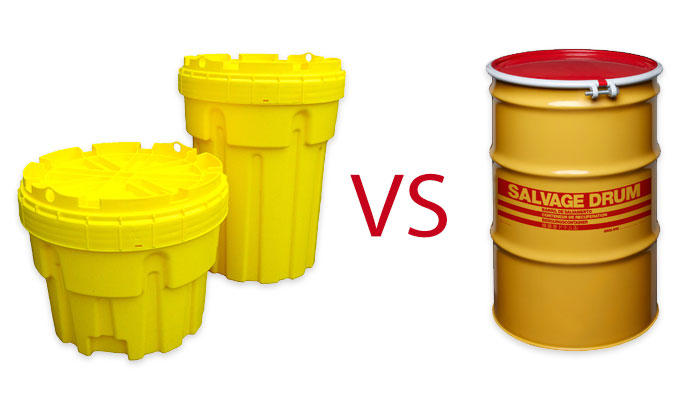Salvage Drums vs. Overpack Drums
The Truth About Salvage Drums - What is the difference between Overpack and Salvage drums?
by Mark Shaw, spillcontainment.com
From the Winter 1998 issue of Environmental Solutions Product News
There is confusion in the marketplace regarding Salvage Drums. The term "Overpack" has become synonymous with "Salvage Drum" in recent years and there are several new products on the market, which look like Salvage Drums, but are not.
What is a Salvage Drum?
Salvage Drums are designed to contain packages of hazardous materials that are damaged, defective, or found leaking. The drums are regulated by the Department of Transportation (DOT) under 49 CFR 173.3 (c). If a company or shipper has a leaking package of hazardous material, sorbents or rags used on a spill or leak, and they wish to ship them across public roads, they must use a Salvage Drum under the restrictions of 173.3 (c). The Salvage Drum is larger than the leaking package allowing the leaking package to be placed inside the Salvage Drum for safe shipment to a disposal or treatment facility. The Salvage Drum must be compatible with the lading in the leaking package. Shipments that do not follow the DOT Hazardous Materials regulations are shipping illegally and could face fines, typically $250.00 - $25,000.00 per violation, levied by the DOT.

Salvage Drums can be made of steel, polyethylene, aluminum or metal and must pass, at a minimum, standard UN performance requirements for drums shipping solids as well as a 3 psi air leak proof test. If a drum meets the requirements as stipulated by DOT under 49 CFR 173.3 (c), then it is to be marked with the appropriate UN markings, proper shipping name of the material, name and address of the consignee, and the words "Salvage Drum." It is illegal to omit these markings from Salvage Drums prepared in accordance with 173.3 (c).
What is an Overpack?
An Overpack is an enclosure used by a single consignee to provide protection or convenience in handling a package, or consolidate two or more packages.
An Overpack is used to contain a smaller non-leaking package. The integrity of the inner package has not been breached and the performance of the entire package still meets DOT requirements. The DOT does not view an Overpack as a Salvage Drum.

Why is there confusion between Overpacks and Salvage Drums?
Traditionally, many manufacturers have referred to Salvage Drums as "Overpacks." So the industry has become more familiar with the term Overpack than Salvage Drum and believes that all Overpacks must be Salvage Drums. This is an incorrect assumption. Recently some manufacturers have been offering drums that look like Salvage Drums but refer to them as "Overpacks." Unless your employees or buyers are very sophisticated on the differences between Overpacks and Salvage Drums under DOT regulations, they may unwittingly purchase these Overpacks believing they are buying drums they can use for Salvage Drum applications. If Overpacks that look like Salvage Drums cost less than Salvage Drums that could be the first tip that the Overpack may not meet the performance standard of a Salvage Drum.
What is my liability if I use or sell an Overpack that is not qualified as a Salvage Drum for a Salvage Drum application?
The DOT holds manufacturers responsible to properly design, test and mark the UN/DOT regulated drums and produce them to a standard that insures performance compliance. Distributors should not sell a drum for a purpose or regulation that it does not meet. Finally, the actual shipper must be knowledgeable enough to use the regulated drums in accordance with the manufacturer instructions and DOT/UN regulations. The manufacturer, distributor or shipper can be held liable if they do not meet their obligations under the DOT/UN regulations.
Can "used" Salvage Drums be reused?
If used more than once, Salvage Drums are subject to the requirements of 173.28. They must be leak tested, and if they show evidence of a reduction in integrity, they must be reconditioned. Salvage Drums that comply with these requirements may be reused or resold. If they have been reconditioned, the reconditioner must mark them. There are other aspects to reconditioning including minimum wall thickness and age of the unit. If you have an opportunity to purchase and use recycled Salvage Drums, make sure they have been retested, certified and marked properly to avoid the risk of non-compliance with DOT regulations in the interest of saving a few bucks.

What should you use for Spill Kit Containers - Salvage Drums or Overpacks?
The most logical choice for a Spill Kit container would be a Salvage Drum. While you could save a few dollars buying an Overpack or an economy type container, when you have a spill and start using the sorbents, that drum will not qualify as a Salvage Drum should you need to ship off the sorbents used in a spill clean-up. Even worse, if you place a leaking package and used sorbents into the Overpack or economy type container, you will need to buy a Salvage Drum large enough to place the container, leaking package and sorbents into for shipping. Buying a Salvage Drum for your Spill Kits initially insures that when you have a leak or spill, the Spill Kit you used to hold the sorbents prior to use, will also allow you to ship off the leaking packages and used sorbents for treatment, disposal and recycling. Instead of buying an Overpack for the Spill Kit, then a Salvage Drum for the clean-up, you will save money and effort by using a Salvage Drum as your Spill Kit.
Remember, Overpacks overpack non-leaking packages for shipment, Salvage Drums overpack leaking packages and sorbents for DOT compliant shipments.
